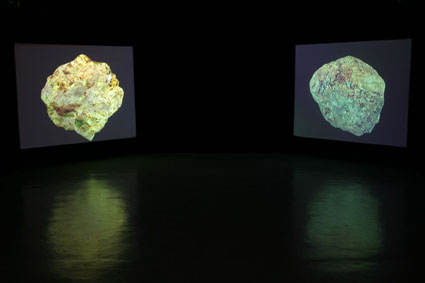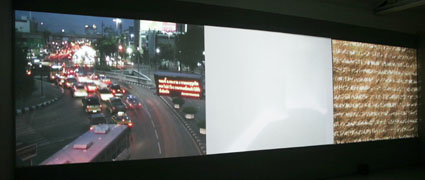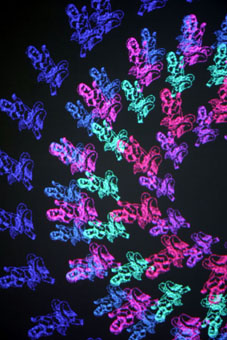 |
Anthony Gross, From Here to Eternity II, Computer animation installation, UK, 2002 - present |
The sense of in-betweenness is pervasive in -+-(negative plus negative), sometimes triggering the curious dialectic suggested by the title, sometimes evoking suspension (and MAAP's gravity theme) both literally and metaphorically, and generating a reflective unease, a reminder that borders are not just lines to be crossed but states where being is denied or can evaporate.
In Wit Pinkanchanapan's Family Portrait (2002; see Virginia Baxter, "The pause that refreshes") the father hoses his hand in the garden. It's a still-life video with a little movement, a kind of involuntary vibration of body and globules of suspended water. There's an odd sense of vulnerability. In the next portrait, in a moment of control and anticipation, the mother in traditional dress holds up a treat for 3 large, eager dogs as high as her waist. The third portrait is of a young woman in a domestic storeroom holding a large blue plastic box labelled "PA Supply." The only subject to look at the camera, she smiles, moving the box ever so slightly up and down, suggesting both the weight of the task and her strength. Apparently she is not 'family.' The son is the portraitist. This woman is a maid, presumably with all the connotations of that role in South-East Asia in terms of labour, migration and exploitation, and the status of the servant as part of the family, or not. The vibration of minimal and repeated action in this trio of images reads like a capture for a time capsule, a quivering trace of middle class Thai life in the early 21st century.
 |
Kamol Phaosavasdi, Techno Temple, Video Installation, Thailand, 2004 |
In a long, darkened space, 2 meteorites in From Here to Eternity II, by British artist Anthony Gross, appear one at a time on separate screens angled slightly towards each other. As one meteorite forms suddenly from a small cluster of tiny stars and rolls through space, the other on the second screen becomes transparent, flares with colour and explodes, and the cycle starts up again. In each appearance the shape of the large meteorite is the same, but it is the colour and texture of the surface which fascinates as it changes cycle to cycle, from a crusty white, to grey, to orange flecked with reds, looking sometimes precious, sometimes hot, snakeskin-like, sometimes stark, icy and threatening. The 'Eternity' evoked here is of endless creation and destruction, a sameness relieved by the beauties of the transformations allowed by colour and form. From Here to Eternity is a novel (and subsequently a famous film) by James Jones about tensions of race, class and sex within the American forces in World War II. Gross' vision offers no narrative and no such specificity, just a series of not big but small beautiful bangs. The overarching rhythm of the turning meteorites punctuated by explosions and the dance of stars prior to re-creation places us again in the in-between, in a visual mantra of the acceptance of cycle and change.
In the 16-minute video loop installation A Song for No Man, Jim Prevett & McArthur (the aggregate name of just one artist) hangs one video monitor from the ceiling with thick rope, tying it to another placed facing it on a chair. On the hung monitor a man hangs in space, we see him from the waist down, jerking about, the result of editing but uncomfortably like watching a hanging. He is suspended over a road that leads to a border control station. People cross the border on a sunny day, officers go about their tasks, while the hanged man is ignored, stuck in-between, between nation states, between life and death. On the second monitor, people wait in transit in what looks like an airport customs control section. A veiled woman stands by her luggage trolleys interminably waiting, but suddenly 2 men wheel them away for her. The soundtrack grumbles with slowed down voices, the dark murmur of authority. Here people seem to pass through the in-between of borders, but slowly. The light of one image, the darkness of the other, the tortuous fixity of the first and the underworld gloom but fluidity of the second play out a grim dynamic.
 |
Sakarin Krue-on, Circle of Hope, Single-screen video, 5-min loop, Thailand, 2003 |
-+-(negative plus negative) is a satisfying and well deployed gathering of works in which border states are experienced not just as content, whether political, moral or psychological, but in vibrations, pulsing and flows, a visual musicality that links all the works in their very different evocations of in-between states.
-+-(negative plus negative), curator Gridthiya Gaweewong, Project 304, Chiangmai, Thailand; organised by Earl Lu Gallery, LASALLE-SIA College of the Arts and MAAP; MAAP in Singapore-GRAVITY, Oct 7-31
RealTime issue #77 Feb-March 2007
© Keith Gallasch; for permission to reproduce apply to [email protected]








 back
back